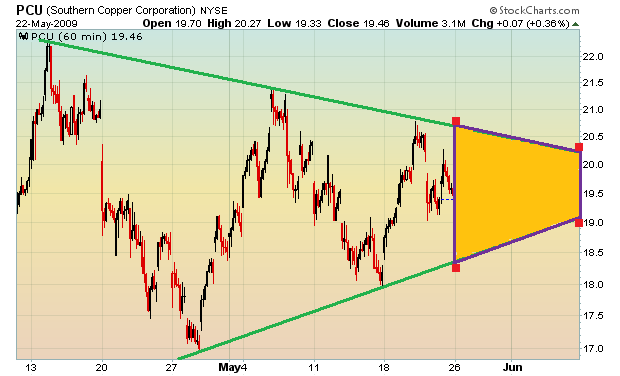|
|
BLANK BOX™ TRADING: A Self-Developed Daily Preparedness Strategy
80
Blank Box™ trading a technique that I’ve developed over my career. It is very simple, as is everything that I do. Basically, it’s adding space for the next day (or days/weeks) to estimate a stock’s future anticipated time frame and move. It will help you make quick decisions on breakouts and help you “hold the line” during times of consolidation. This method works for all time frames and all stocks and markets. It also works with all technical patterns, such as neutral channels, symmetrical/ascending/descending triangles, flags, pennants, wedges, tops, bottoms, etc. I will cover long-only patterns in this article.
Some people say that technical analysis is “hindsight”, and that my blog posts are also “hindsight”. Bullshit. Those people are the dumbest box of Pet Rocks (le Duc, et. al.) that obviously have no trading foresight whatsoever. This kind of thinking also demonstrates a lack of experience and tactical strategy. True, technical analysis looks at past price performance to determine future movement, but why do patterns work and why are they so reliable and repetitive?
The answer is because the markets are driven by human behavior, so as long as humans are still trading, it won’t change. Humans are emotional creatures. It is not about hindsight, it’s about looking into the future. After all, aren’t all styles of trading about looking into the future and attempting to get in prior to a move? Take a look into my crystal ball:
The Purposes of the Blank Box™:
1) Determine low-risk, high-probability entry and exit points
2) Predict bounces and pullbacks intra-day
3) Psychological self-control
Let’s take a look at a real-time, and not a “hindsight” example, of PCU, currently trading at $19.46:
Below is a 45-day of PCU. I have also added 2 weeks of “blank days” to nearly complete the apex of the symmetrical triangle. It is important to note that the box remains constant, but price does not. If a breakout were to occur on Tuesday, I would be looking at the gap up to start at around ~$20.70. Likewise, a breakdown would be indicated by a gap down below ~$18.30. If the consolidation continues, the box becomes more narrow as each day passes and may morph from a ~$2.50 range to a ~$1.25 range.

Let’s look at my early morning Friday post on the SPX. The first chart is the 3-day chart with Friday being the “blank day”. The chart below the first one is what actually happened on Friday.


I wonder why people make trading so complicated with pages of fundamentals, zillions of technical indicators, spreadsheets with time-consuming data, and everything else that is completely unnecessary, when in fact, trading is so simple. Keep it simple folks. My 10-year old cousin, my protégé, is up over 20% this year, putting most institutions to shame. FYI - she starts middle school in the Fall.
Creating the Box
How do you make one? The boxes are dependent on two (three) important factors:
1) Time - what is the time frame?
2) Pattern - what kind of pattern is it?
3) Your drawing skills and knowledge of basic Geometry.
I laid out examples of the SPX and PCU for a reason. The SPX was forming a neutral range and therefore, it needed only one blank day. PCU is currently forming a symmetrical triangle and the apex is farther away. The time aspect depends entirely on pattern, and more importantly, the pattern aspect determines the time. Once you get this down perfectly, you’ll be able to win so much that people will think you are a goat-sacrificing devil worshiper.
Let’s take a look at a two more real-time, non-hindsight, examples below:
1) HBAN, $4.24, pennant-down sloping

2) CEG, $25.62, triangle-symmetrical

Caveats
Too good to be true? Sometimes. Why? Because nothing is perfect. The most common reason for loss is if the move outside of the box is a false breakout (or breakdown) which pulls back (or throws back) into the box. This is an immediate cause to exit the trade without any hesitation. You will take small losses along the way, but your gains should outstrip your losses. Cut the losses quickly, because if you are right about it, then you will have saved yourself a headache, and if you are wrong, then you can always re-enter anyway.
I believe that the second most common reason is pattern failure. Sometimes, patterns just don’t work out the way the textbook states. You just simply get out and move on.
—
Trading is about making money, not about how smart you look or sound. Remember to keep things simple. Trading is hard if you make it hard. Likewise, trading is easy if you make it easy |
|